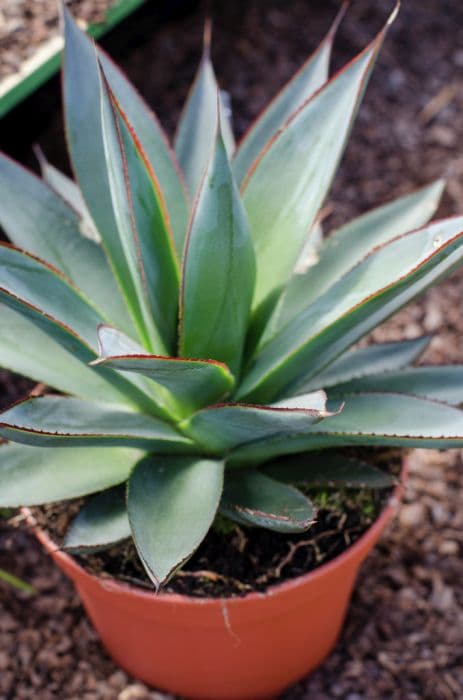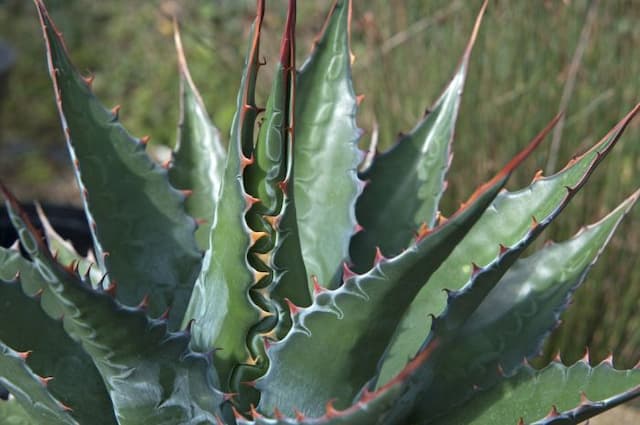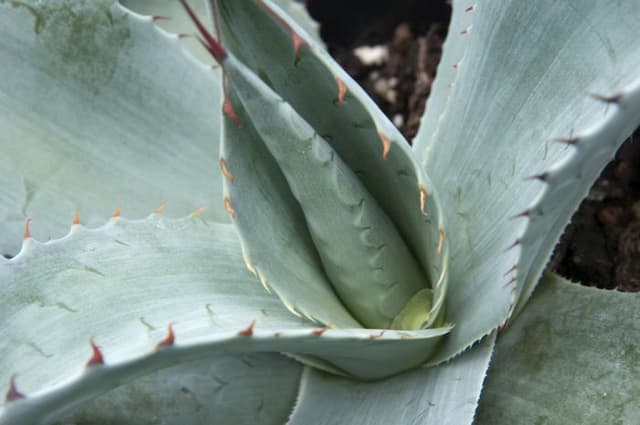Plantain Lily Hosta 'Minuteman' (fortunei) (v)

ABOUT
Hosta 'Minuteman' is a striking perennial known for its ornamental foliage, which brings a vibrant contrast to garden spaces. The plant displays broad, heart-shaped leaves that exhibit a unique variegation pattern. These leaves are characterized by their deep green centers surrounded by a crisp, white margin that stands out distinctly against the greenery. The contrasting coloration provides a bold and dramatic effect, making Hosta 'Minuteman' a popular choice for shady gardens where it can really pop against darker surroundings. Furthermore, in the summer months, the foliage is complemented by tall stalks that bear bell-shaped, lavender or purple flowers. These delicate blossoms rise above the foliage and sway gently in the breeze, adding a delightful touch of color and movement to the plant's overall appearance. The leaves of Hosta 'Minuteman' are not only remarkable for their coloration but also for their texture. They possess a slightly rugged surface that can add an interesting tactile element to the garden. Their substantial leaf structure also means they are less favored by slugs and snails compared to other hostas with softer leaves, making 'Minuteman' a practical as well as aesthetically pleasing choice for many gardeners. Despite not discussing size, it's notable that this plant forms a mound-like shape that fills its space with lush foliage, creating a dense and eye-catching ground cover.
About this plant
 Names
NamesFamily
Asparagaceae.
Synonyms
Minuteman Hosta, Variegated Plantain Lily, Funkia.
Common names
Hosta fortunei 'Minuteman'.
 Toxicity
ToxicityTo humans
Hostas, including the Hosta 'Minuteman', are generally not considered toxic to humans. There is little to no evidence of severe poisoning from ingesting parts of hostas. However, as with any non-food plant, ingestion can potentially cause mild stomach upset or an allergic reaction in some individuals.
To pets
Hostas are known to be toxic to pets, especially to dogs and cats. If a pet ingests part of a hosta plant, symptoms of poisoning may include vomiting, diarrhea, and depression. Although hosta poisoning is generally not fatal, a pet that has consumed a large amount of the plant should be monitored by a veterinarian, as dehydration from vomiting and diarrhea can be a concern.
 Characteristics
CharacteristicsLife cycle
Perennials
Foliage type
Deciduous
Color of leaves
Variegated
Flower color
Lavender
Height
1-2 feet (30-60 cm)
Spread
2-3 feet (60-90 cm)
Plant type
Herb
Hardiness zones
3-8
Native area
Asia
Benefits
 General Benefits
General Benefits- Shade Tolerance: Minuteman Hosta thrives in shade, making it ideal for gardens with limited sunlight.
- Low Maintenance: Requires minimal care once established, which makes it suitable for beginner gardeners.
- Attractive Foliage: Features striking green leaves with white margins that add visual interest to garden spaces.
- Ground Cover: Its dense growth habit can help suppress weeds and cover bare spots in the landscape.
- Drought Resistance: Once established, it can tolerate periods of dryness, which is beneficial in water-restricted areas.
- Cold Hardy: This plant is capable of surviving cold winters, expanding its suitability to various climates.
- Design Versatility: Can be used in a variety of garden designs, including borders, containers, and as a specimen plant.
- Pest Resistance: Minuteman Hosta is generally resistant to common garden pests, reducing the need for chemical treatments.
- Seasonal Interest: Offers visual interest across multiple seasons with its foliage and summer blooms.
 Medical Properties
Medical PropertiesThis plant is not used for medical purposes.
 Air-purifying Qualities
Air-purifying QualitiesThis plant is not specifically known for air purifying qualities.
 Other Uses
Other Uses- Hosta 'Minuteman' can be used in floral arrangements, offering unique foliage texture and variegation to complement flowering plants.
- The leaves of Hosta can serve as natural platters or decorative wraps for outdoor dining, providing an eco-friendly presentation for appetizers.
- Dried Hosta leaves can be crafted into bookmarks, preserving the beauty of the garden in a practical form for book lovers.
- Hosta leaf casting with concrete or plaster creates detailed garden ornaments or stepping stones, capturing the intricate vein patterns.
- Hosta leaves can be used as a natural dye source for fabrics, giving a soft green hue to textiles.
- The robust leaves of Hosta can be incorporated into garden-themed art projects, such as leaf printmaking or botanical collages.
- Creating a garden theme in aquariums, non-toxic leaves from Hostas can be used as decor, provided they are cleaned and free of pesticides.
- Hosta leaves can be used to line the bottoms of wire plant baskets, adding an aesthetic touch while helping retain soil and moisture.
- During garden photography, Hosta plants can serve as a lush, green backdrop or a contrasting element for highlighting colors in smaller flowers.
- Hostas can be used in educational settings, teaching children about plant biology, leaf structure and variegation through hands-on activities.
Interesting Facts
 Feng Shui
Feng ShuiThe Hosta is not used in Feng Shui practice.
 Zodiac Sign Compitability
Zodiac Sign CompitabilityThe Hosta is not used in astrology practice.
 Plant Symbolism
Plant Symbolism- Resilience: Hostas are known for their ability to thrive in various conditions, symbolizing resilience and adaptability.
- Devotion: With their lush foliage that returns every year, hostas can represent devotion and loyalty in relationships.
- Friendship: The easy-to-share nature of hosta plants, which can be divided and propagated, symbolizes the growth and nurturing of friendships.
- Heartiness: These plants are robust and hearty, symbolizing strong life force and good health.
 Water
WaterThe Hosta 'Minuteman' prefers evenly moist soil, so it's important to water it regularly but not excessively. During growing season, apply about 1 inch of water weekly, which translates to approximately 0.623 gallons per square foot if you know the area of your plant's bed. In periods of drought or extreme heat, increase watering frequency to maintain soil moisture. Avoid watering the foliage directly to reduce the risk of leaf diseases; instead, water at the base of the plant. During the winter months or dormancy period, reduce watering as the plant's water requirements decrease.
 Light
LightHosta 'Minuteman' thrives best in partial to full shade. It is ideal to place it where it can receive dappled sunlight or light shade, avoiding the intense midday sun which can scorch its leaves. These perennials can tolerate some morning sun but fare better in spots that stay relatively cool and shaded throughout the hotter parts of the day.
 Temperature
TemperatureThe Hosta 'Minuteman' is hardy and can endure temperatures as low as -40 degrees Fahrenheit but performs best in temperatures between 50 and 75 degrees Fahrenheit. Optimal growth occurs when night temperatures are cool and the days are moderately warm. These plants go dormant in colder winter months but can withstand short periods of higher temperatures without significant damage.
 Pruning
PruningPruning Hosta 'Minuteman' mainly involves removing any dead or damaged leaves to maintain a tidy appearance and remove potential disease or pest harborage. After the first frost in fall, cut back the foliage to an inch above the soil level to prepare for winter. Pruning is only required once per year, usually done at the end of the growing season.
 Cleaning
CleaningAs needed
 Soil
SoilThe Minuteman Hosta thrives in moist, well-draining soil enriched with organic matter. The ideal soil mix should comprise equal parts garden soil, peat moss, and perlite to ensure good aeration and water retention. The soil pH should be slightly acidic to neutral, ranging from 6.5 to 7.5.
 Repotting
RepottingMinuteman Hosta typically requires repotting every 3 to 4 years to refresh the soil and provide space for growth. The best time to repot is in the spring, just as new growth begins.
 Humidity & Misting
Humidity & MistingMinuteman Hosta prefers a moderate humidity level, which can be achieved outdoors naturally. Indoor plants benefit from occasional misting or placement on a pebble tray with water to maintain adequate humidity.
 Suitable locations
Suitable locationsIndoor
Plant Minuteman Hosta in well-lit room away from direct sunlight.
Outdoor
Plant in shaded area with moist, fertile soil and good drainage.
Hardiness zone
3-8 USDA
 Life cycle
Life cycleThe Hosta 'Minuteman' begins its life cycle as a dormant rhizome or division planted in the ground, ideally in early spring or fall. As temperatures warm, shoots emerge from the rhizome, and the plant begins to develop its characteristic broad, variegated leaves. Throughout the spring and summer, the Hosta 'Minuteman' grows vigorously, forming a low, mounded clump of foliage that can be used as groundcover or ornamental accent. During mid-summer, tall flower stalks rise above the foliage, bearing lavender to white funnel-shaped flowers that attract bees and other pollinators. After blooming, the plant puts energy into root and foliage growth until the arrival of fall, when the leaves die back with the first frosts. The plant overwinters as a dormant rhizome, conserving energy to restart the cycle the following spring.
 Propogation
PropogationPropogation time
Late spring to early summer
Propogation: Hosta 'Minuteman', more commonly known as Minuteman Hosta, is typically propagated through division, which is the most popular and effective method for this perennial plant. The best time to divide Minuteman Hosta is in early spring or early fall when the plant is not in active growth. To propagate by division, carefully dig up the entire clump of the hosta, making sure to include as much of the root system as possible. Using a sharp, clean knife or spade, slice through the root ball to separate it into smaller sections, each containing at least two or three shoots with corresponding roots. Replant these divisions immediately, setting them at the same depth they were growing previously, and water them thoroughly to help establish the new plants. This method allows gardeners to quickly and effectively increase their stock of Minuteman Hostas while also rejuvenating older, overcrowded clumps.









